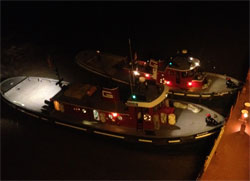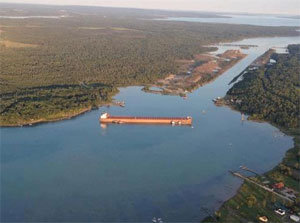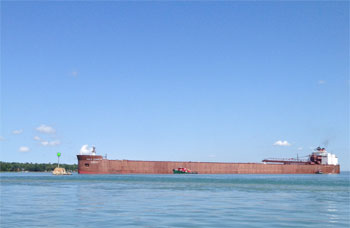A 1,013-foot self-unloading bulk carrier ran aground and pivoted sideways, becoming stuck on both sides of the St. Marys River channel and blocking a crucial Great Lakes shipping lane for more than a day.
Paul R. Tregurtha, the largest ship operating on the Great Lakes, suffered extensive hull damage in the Aug. 15 grounding that was blamed on pilot error.
“Everything with the vessel worked fine,” said Bob Dorn, senior vice president of Interlake Steamship Co., which owns the vessel. “The long and the short of it was, (the captain) started his turn too late.”
 |
|
Tugboats Florida and Missouri maneuver the laker to refloat it. |
The bulk carrier was carrying 62,000 tons of coal. The grounding occurred at about 0300 near the entrance to a narrow, man-made channel known as Rock Cut about 15 miles south of Sault Ste. Marie, Mich. The vessel’s starboard bow ran hard aground on a shoal. Its stern grounded after the river’s current pushed it onto the riverbank.
Downbound transit along a route that connects Lake Huron with Lake Superior was effectively blocked for more than a day, delaying 11 vessels, according to the U.S. Coast Guard. Tregurtha was bound for the St. Clair Power Plant near Detroit with the coal loaded in Superior, Wis.
Nobody was injured in the accident, which remains under investigation by the Coast Guard, said Petty Officer 2nd Class Levi Read, a spokesman with the Ninth Coast Guard District in Cleveland. There was no pollution or environmental damage.
The Coast Guard declined to make the investigating officer available for an interview.
Within two hours of the accident, Interlake Steamship activated its Incident Response Team and chartered a plane to carry several executives to the accident scene. Within 12 hours of the grounding, a salvage plan had been created and tugboats and salvage experts were standing by, said Tom Wynne, Interlake’s chief counsel.
The salvage, which began at about 0130 on Aug. 16, consisted of first pushing Tregurtha’s stern back toward the center of the channel. Then, weight was added to compartments in the vessel’s stern to ease pressure on the bow. Finally, the tugboats Florida and Missouri — operated by Great Lakes Towing with a combined 4,000 hp — were able to pull the vessel off the shoal.
 |
|
Passage in the river was completely blocked when the 1,013-foot bulk carrier became stuck bow-to-stern across the channel. |
Capt. John Wellington of Sault Ste. Marie-based Wellington Maritime assisted with the salvage, Wynne said.
Tregurtha was freed at about 0600, 27 hours after running aground.
“I can’t over-emphasize enough how cooperative the USCG was,” Wynne said. “They were diligent in engaging the proper people in their organization to review and approving our plan, and then stood by and allowed us to execute that plan.”
“We couldn’t have asked for better cooperation,” said Dorn.
Tregurtha suffered “significant damage” to the hull around and under the bow and to its port rudder. After the vessel was freed, its cargo was offloaded and it was taken to Bay Shipbuilding, in Sturgeon Bay, Wis., for repairs.
Workers at the shipyard spent about three weeks repairing the hull, while the rudder was re-machined by Northern Machining & Repair of Escanaba, Mich.
Dorn said Tregurtha was back in service 30 days after the grounding.

